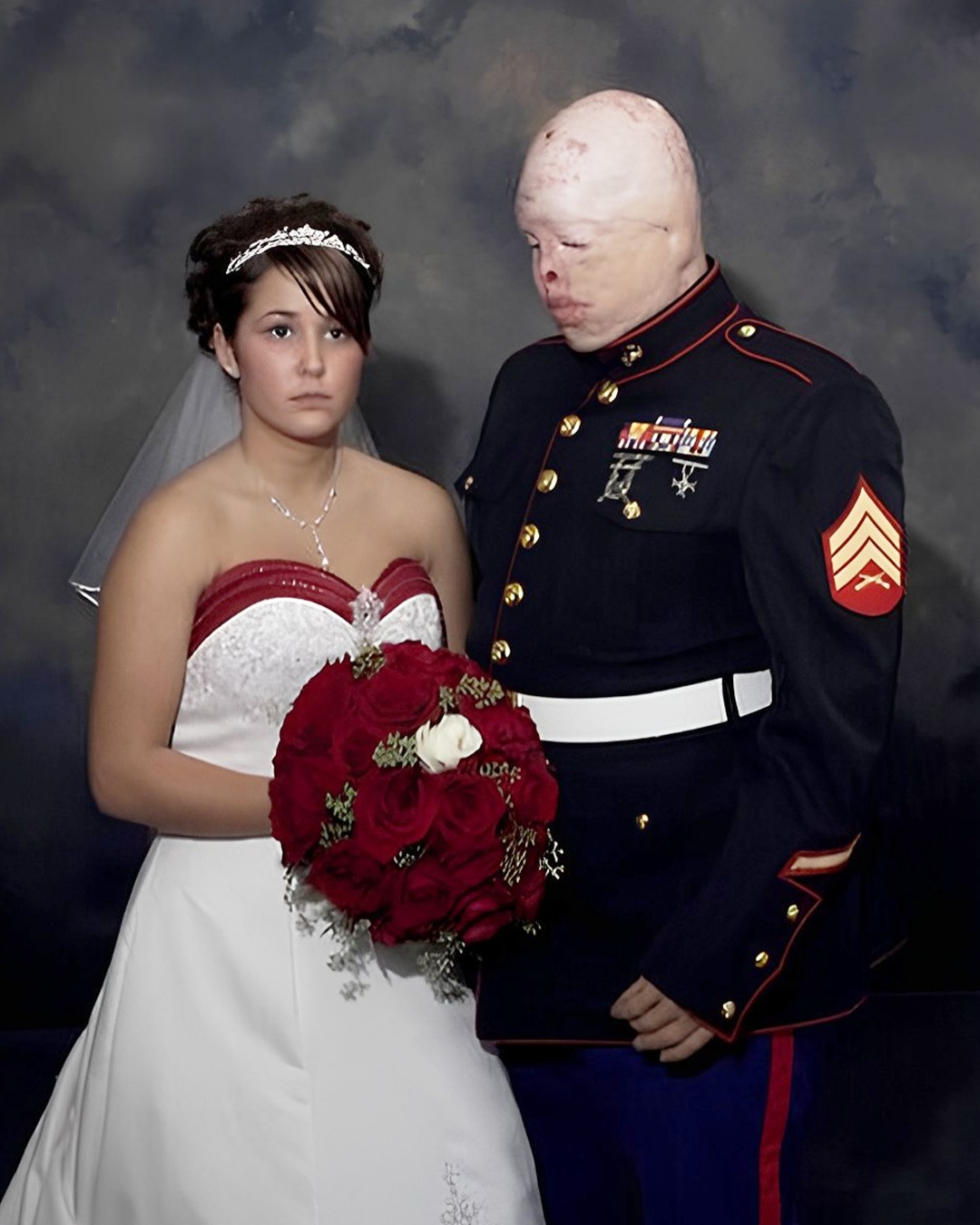In the spring of 2004, Marine Sgt. Tyler Ziegel was stationed in Iraq, serving his country with the courage and dedication that had always defined him. A native of Illinois, Tyler had joined the Marines with a sense of duty and purpose, eager to protect his nation and serve alongside his brothers and sisters in arms. But in an instant, that mission changed. On a fateful day in Iraq, a roadside bomb—an improvised explosive device designed to maim and kill—detonated near his vehicle. The explosion would forever alter the course of his life, leaving burns across more than 70% of his body, taking parts of his face, fingers, and even his vision in one eye.
The immediate aftermath was chaos. Fellow Marines rushed to save him, fighting against time, blood loss, and the uncertainty of survival. Tyler’s body, ravaged by the blast, became a battleground itself. He was flown to military hospitals, enduring hours of emergency care while doctors fought to stabilize him. Even as the medical teams worked tirelessly, the prognosis was grim. Tyler survived, but the road ahead would be filled with surgeries, pain, and a struggle that extended far beyond the physical injuries he sustained.
Over the following years, Tyler faced a grueling recovery process. He underwent more than 50 surgeries, each one designed to repair the damage caused by the blast, restore some semblance of normalcy, and give him a chance to live with dignity. Skin grafts, reconstructive surgery, and countless hours of rehabilitation became the new reality of his life. Every day was a test of endurance, not just for his body but for his spirit. Even the simplest tasks—grasping objects, seeing clearly, or moving without assistance—were monumental challenges. Yet through it all, Tyler exhibited a determination that inspired everyone who met him.
In 2006, two years after the blast, Tyler’s story became one of hope and resilience in a way the world could see. He married his high school sweetheart, Renee, in a ceremony that captured the hearts of people around the globe. The wedding photo, featuring Tyler in his military uniform and Renee standing beside him, became iconic. The image showed love and commitment that transcended physical appearance, trauma, and the scars that Tyler bore. For many, it symbolized the triumph of the human spirit over the most unimaginable adversity—a visual testament to courage, resilience, and unwavering devotion.
However, the external symbol of triumph belied the ongoing battles Tyler faced within. Life after war brought struggles that were invisible but no less real. The psychological scars, including PTSD, haunted him as relentlessly as his physical injuries. Nightmares, flashbacks, and the constant hum of trauma were ever-present. Chronic pain, a daily reminder of the blast, demanded constant attention and management. He was living in a body that would never fully heal, in a mind that was burdened with memories of conflict, and in a world that sometimes saw him more as a symbol than as a person.
Despite the global recognition and admiration he received, Tyler’s personal struggles deepened. His marriage, though initially a beacon of hope, faced immense pressure from the realities of his condition. The demands of physical therapy, the emotional weight of trauma, and the complexities of daily life eventually strained the relationship. While Renee remained a source of support and love, the couple ultimately separated. For Tyler, this was another wound on top of those he had endured physically—a reminder that survival does not automatically bring peace, happiness, or a return to normalcy.
Tyler’s story also highlighted broader issues faced by wounded veterans returning from war. His experiences underscored the challenges of reintegration into civilian life, the necessity of mental health support, and the struggles many veterans face when coping with physical and psychological injuries simultaneously. Programs aimed at helping veterans recover, while essential, often fell short of addressing the complex, intertwined needs of someone living with both visible and invisible wounds. Tyler’s life became a case study in the importance of comprehensive care for those who risk everything in service to their country.
Tragically, the ongoing pain and challenges Tyler endured culminated in his premature death. In 2012, at just 30 years old, Tyler died from an accidental overdose of pain medication. His passing was sudden, shocking, and devastating to those who knew him. It was a stark reminder that even heroes are vulnerable, and that the scars of war extend far beyond the battlefield. Tyler’s death was not just a personal loss for his family and friends but also a national loss, for his story had touched people worldwide.
In remembering Tyler Ziegel, it is impossible to focus solely on the physical injuries he endured. His life was a testament to human resilience, to the capacity for love and courage in the face of overwhelming adversity, and to the harsh realities that many veterans confront long after the combat zone has faded from view. Tyler showed the world that strength is not just measured in physical survival but in the willingness to face each day, to persevere, and to strive for moments of connection and joy despite immense suffering.
His marriage to Renee, while not lasting, remains a powerful symbol. The photo of the two of them standing together in the aftermath of war has inspired countless people, serving as a visual reminder that love can endure through trauma and that human connection provides meaning even in the darkest of circumstances. Yet the story behind the image—the months and years of surgeries, pain, and emotional struggle—is equally important, for it paints a fuller picture of what it means to survive.
Tyler’s life also raises important questions about how society supports veterans. The combination of physical disability, chronic pain, PTSD, and societal expectations creates an environment where even the strongest individuals can struggle to cope. Tyler’s accidental overdose highlights the critical need for accessible mental health care, comprehensive pain management programs, and social support networks that address both the visible and invisible scars of war.
In reflecting on Tyler Ziegel’s journey, one is struck not only by the magnitude of his suffering but also by the courage and dignity with which he lived. He faced challenges that most people cannot begin to imagine, endured pain that would break the spirit of many, and yet he continued to fight—to rebuild his life, to maintain relationships, and to be present for those he loved. His story is heartbreaking, yes, but it is also deeply instructive, offering lessons about resilience, the human capacity for love, and the urgent need to support those who serve.
Today, Tyler is remembered not just as a soldier, not just as a victim of war, and not just as a symbol, but as a human being who experienced the full range of life’s joys and sorrows under extraordinary circumstances. His legacy is multifaceted: it is the photograph with Renee, a symbol of love enduring beyond trauma; it is the memory of his determination to survive when every physical and psychological force was against him; and it is a cautionary tale about the hidden battles that many veterans continue to fight long after the headlines fade.
Tyler Ziegel’s story continues to inspire, to move, and to challenge. It reminds the world that courage is not always loud, that heroism is not always about the battlefield, and that survival does not end with the end of physical wounds. His life, marked by sacrifice, love, struggle, and resilience, will continue to resonate with anyone who has faced adversity, anyone who has loved against the odds, and anyone who seeks to understand the profound costs of war.
In remembering Tyler, one cannot ignore the duality of his existence: the public symbol of hope and triumph, and the private struggle with pain, loss, and trauma. His life and death serve as a call to honor veterans not only for their service but for the ongoing challenges they face once they return home. They remind us that the fight does not end on the battlefield, that courage is ongoing, and that love, even in the most difficult circumstances, remains a guiding light.
Tyler Ziegel’s story is a narrative of humanity, resilience, and tragedy. It is a chronicle of the physical and emotional toll of war, of the power of love to inspire in the face of suffering, and of the stark reality that surviving the battlefield is only the beginning of a much longer journey. In remembering his life, the world honors not only the Marine and the soldier but the man, the husband, and the human being who fought valiantly, loved deeply, and endured more than most could imagine.

